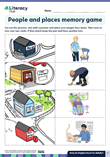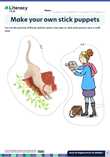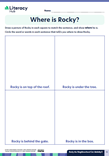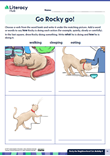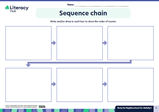Rocky the Neighbourhood Cat
This imaginative recount describes the busy day of a friendly cat called Rocky as he visits various places in the local community. When Rocky’s owner arrives home to find Rocky sound asleep she wonders if he has been asleep all day.
Back to the shared reading overview page
Text download
Rocky the Neighbourhood Cat as PDF (5.5MB) (opens in new window)
Rocky the Neighbourhood Cat as PowerPoint slideshow (11.8MB) (download)
Printable worksheets
|
|
|
|
|
| People and places memory game (1.4MB) | Make your own stick puppets (408KB) | Where is Rocky? (78KB) | |
|
|
|

Teaching & learning sequence
This teaching and learning sequence outlines classroom strategies for Rocky the Neighbourhood Cat, including:
- ways to incorporate the ‘Big Six’ core elements of reading development
- fun, engaging and adaptable student activities for a diverse range of abilities
- links to the Australian Curriculum.
| Text features | Cross-curriculum links to the Australian Curriculum |
|
|

First read
As a whole group, enjoy sharing the text and learning together.
Engage
Engage students in a class discussion. Do you have a pet? Have students turn and talk to a partner about this, and then invite them to share their personal anecdotes about their pets.
What do you think your pet does when you are at school all day? Discuss students’ ideas.
Introduce the character Rocky by explaining that you are going to read a book about a cat called Rocky who gets up to all sorts of things while his owner is out.
Read the Author’s note on page 32. What places do you think Rocky might visit in his community? Use students’ ideas to create a list of community places on a chart (keep the chart to revisit later).
Read aloud
Read Rocky the Neighbourhood Cat aloud to the class. Provide time during the read-aloud for the students to make comments or ask questions.
Make meaning
Revisit the illustrations. Have students view pages 6 and 7 closely. What can you see in this illustration? If need be, prompt them to spot the legs of Rocky’s owner. Encourage them to look for Rocky’s owner in other illustrations throughout the book. Why do you think the illustrator drew Rocky’s owner in the background in these illustrations? Discuss and then revisit page 29 and reread the owner’s question to Rocky: ‘Have you been asleep here all day?’ What makes this an interesting question? Why do you think the author wrote it? Discuss and draw out that the owner thinks Rocky has slept all day, when in fact he has been out and about at many of the same places that his owner visited.
Encourage students to make personal connections with the text. What places do you visit in your community? What members of your local community do you see when you are out? Provide time for students to share their personal experiences.
Revisit the text
Return to the text several times to look more closely at different aspects of its content, structure and language features. This is a great vehicle for exploring the ‘Big Six’ of literacy in an integrated way, with all components linking to the same text.
Comprehension
Reading is about making meaning. Choose from these comprehension activities to help your students explore the text deeply, make personal connections, develop new understandings, and draw conclusions. The activities will also help students analyse the text, think critically about it and form their own opinions.
Talking text types (whole-group activity)
Initiate a class discussion: Is this text an imaginative text, or an informative text? Have students give their opinion and encourage them to justify their reasons. Discuss their ideas and draw out that it is an imaginative text, but it has a realistic setting with realistic characters and it is based on a true story, so it is something that could happen.
Pose another question: We know that Rocky the Neighbourhood Cat is an imaginative text, but is it a narrative? Discuss and explain that unlike a narrative that has a problem and a solution, this imaginative text is a recount.
Talk about the purpose of a recount. Discuss and draw out that a recount describes a series of events, in this case the events that happened in Rocky’s day. Can a recount be true? Discuss and explain that a recount can be either fictional (imaginative) or factual (informative).
Check if students, particularly English as an additional language or dialect (EAL/D) students, need extra support with understanding the differences between factual and imaginative recounts. Support these students by orally modelling a factual recount, for example, what you did on the weekend, and an imaginative recount, for example, your trip to the moon. Talk about the similarities and differences in your recounts.
Australian Curriculum links
Sequencing events (small-group activity)
Revisit the map on pages 30 and 31. Use it to talk through the sequence of Rocky’s day out. Where did Rocky go first? Where do he go next? After visiting the post office where did he go? What place did he visit before he went home? Invite students to point to the places as they talk about each one.
On a large chart, model a simple story map using writing and pictures to retell the recount in sequence.
Have students work in small groups to create a story map using felt tip pens on a large sheet of paper. Encourage groups to use words and pictures to summarise the recount. Have groups share their story maps with the whole class.
Australian Curriculum links
Community people and places (partner activity)
Revisit the list of community places created before reading. Now that we have read about the places Rocky visited in his local community, what other places can we add to our list? Talk through students’ ideas and discuss each of the places mentioned. Talk about the purpose of each community place, who works there, and who visits that place.
Have students cut out the images on the printable People and places memory game worksheet and use them to play a game of memory.
Print the People and places memory game.
Australian Curriculum links
Phonological awareness (including phonemic awareness)
These activities will help students to hear the sounds and rhythms of language. Guide them as they explore syllables, onset and rime and listen for phonemes – the smallest units of sound within a word. Use the activities to help your students identify the phonemes in words and practise blending, segmenting and manipulating these sounds.
Hearing alliteration (whole-group activity)
Revisit pages 20 and 21 and read aloud. What did Rocky eat? (‘Favourite, fish-flavoured cat food’.) What do you notice about these words? Discuss and draw out that most of the words begin with the f sound. Have students turn to their partner and talk about other words that begin with this sound. Have them share their ideas and orally brainstorm words beginning with the f sound.
Explore more alliteration in the text by focusing on the repeated phrase ‘Rocky stretched low and long’, and the phrase on page 9, ‘long, lazy sleep’. As a group, talk about words that begin with the l sound.
Similarly, you can focus on the t sound using the phrase ‘twitch of his tail’.
Australian Curriculum links
Fun with phonemes (whole-group activity)
Use the word ‘cat’ to manipulate phonemes through deletion and substitution. What would the word ‘cat’ sound like if I took away the k sound at the beginning? (a-t). What would it sound like if I changed the k sound to a p sound? Have students say the word ‘pat’ slowly blending the three sounds together (p-a-t).
Have students suggest another sound that could go at the beginning of the word ‘cat’ to make a new sound such as h as in ‘hat’, b as in ‘bat’, f as in ‘fat’, m as in ‘mat’ and r as in ‘rat’.
Repeat using other consonant-vowel-consonant (CVC) words from the text such as ‘dog’ and ‘bed’.
Australian Curriculum links
Phonics
Evidence shows that children learn best about the relationship between phonemes and graphemes when instruction occurs through a daily structured synthetic phonics program (also known as systematic synthetic phonics). Knowing about these relationships will help students to decode, and this is crucial for their continued reading development.
In addition to your phonics program it is helpful to expose students to letter–sound relationships they come across in other contexts, such as during shared reading experiences. Choose activities that are relevant to your students so they can practise and reinforce already learnt concepts, so as to build automaticity in recognising letter–sound relationships.
Reading and writing CVC words (whole-group activity)
Write the name ‘Gus’ on a chart. Ask students to say the sound that each letter makes: g, u, s. Model how to blend the sounds from left to right to say the whole word. Have the students join with you to blend the sounds and say the word ‘Gus’. Have students write the word on mini-whiteboards. Encourage them to say each sound from left to right as they read the word.
Repeat using other CVC words from the text such as ‘cat’, ‘dog’, ‘bed’ and ‘pat’ to highlight common letter–sound correspondences.
Australian Curriculum links
- Foundation: AC9EFLY12
Hearing sounds in ‘Rocky’ (whole-group activity)
Use the name ‘Rocky’ to discuss letter–sound correspondences. Choose sounds appropriate to the ability of your students.
What sounds can you hear in the word Rocky? Have students take turns saying each sound they hear to their partner. Write the word ‘Rocky’ on a chart. Break it into individual sounds r, o, k, long e. Talk through the letters that represent each sound (r making r, o making o, ck making k, y making long e). Focus on ‘r’ making the r sound. Have students brainstorm other words they know with this sound such as ‘road’, ‘red’, ‘race’ and ‘roar’, and write them on a chart.
Repeat the activity, but this time focus on ‘o’ making the o sound as in ‘hot’, ‘chop’, ‘odd’ and ‘fog’.
Highlight the letters ‘ck’ making the k sound in Rocky, and talk about other words that have this sound. Highlight words where the k sound is represented by letters other than ‘ck’, such as koala, cat, quiet and school.
Repeat with a focus on ‘y’ making the long e sound. Challenge students to think of words where the long e sound is represented in various ways such as by ‘y’ as in Rocky, ‘e’ as in me, ‘ee’ as in meet, ‘ea’ as in beat and ‘ey’ as in monkey.
Australian Curriculum links
Practising the ar vowel sound (whole-group activity)
If your students have learnt the ar vowel sound have them practise recognising it by revisiting pages 4, 5, 6 and 7. Read these pages aloud, and ask: What words on these pages have the ar sound in them? Have students turn to their partner and talk about this before sharing their ideas. Use students’ ideas to create a list (past, car, park, supermarket). Invite students to underline the letter/s in each word that make the ar sound.
Highlight the word ‘past’, and discuss and draw out that the letter ‘a’ makes the ar vowel sound in this word. Point out that this is a less common way for the ar sound to be represented.
Australian Curriculum links
What’s that sound? (whole-group activity)
Revisit and reinforce uncommon letter–sound correspondences using words from the text. Use the prepositional word ‘through’ on page 6 to explore the letter cluster ‘ough’ making the oo sound. Write ‘through’ on a chart and ask: What sounds can you hear in the word ‘through’?
Underline the letters ‘ough’ and ask students to say the sound that these letters make in this word (oo). Have them think of other words with the oo sound such as shoe, who, blue and new and add these to the chart. Invite students to underline the letter/s in each word that make the oo sound.
Australian Curriculum links
Double letter search (whole-group activity)
Revisit the text and ask students to search for words with double letters such as ‘sunny’, ‘trotted’, ‘fell’, ‘office’, ‘slipped’, ‘narrow’, ‘purred’ and ‘tummy’. Write these words on a chart. Invite students to underline the double letters in each word.
Have pairs of students take turns segmenting the phonemes in each word and saying the individual sounds slowly to their partner. For example, for ‘sunny’ the students would say the sounds: s – u – n – long e.
Australian Curriculum links
Oral language
Oral language development begins at birth, and having a rich oral language is beneficial as a foundational and ongoing resource for literacy development. Oral language is embedded throughout the shared reading experience as students listen and respond to quality texts.
It is also valuable to involve students in specific activities that will continue to improve their oral language skills. Choose from these activities to help students develop and practise important communication skills.
Retell (partner activity)
Have students create stick puppets of Rocky and Rocky’s owner using the printable worksheet, craft sticks and tape. Have them work with a partner using the stick puppets as a prop, to retell Rocky the Neighbourhood Cat. Have pairs practise their retelling and then join with another pair and take turns sharing their retellings with each other.
Print the Make your own stick puppets worksheet.
Australian Curriculum links
Interview with Rocky (partner activity)
Discuss with the class: If you could ask Rocky some questions about his day, what would you ask him? Have students share their ideas.
Have students work with a partner to come up with some questions to ask Rocky, and the answers that Rocky might give. Encourage them to be creative and use their imagination when formulating their questions and answers. Have pairs practise their questions and answers. Discuss the use of appropriate speaking and listening behaviours as they do so.
Pairs could present their mock interviews to the whole class.
If required, support EAL/D students by discussing what a question is, what it sounds like, and how to phrase different types of questions. Model some questions they could ask Rocky, for example: Who did you see at the post office, Rocky? What did you eat at the fire station? What did you do at the police station? Model how to use the text to find the answers to each of the questions in turn. Encourage the students to search the illustrations for the answers.
Australian Curriculum links
Fluency
Activities aimed at teaching and practising fluency are important for students on their journey towards becoming independent readers. Explicitly modelling fluency and providing opportunities for students to practise reading aloud are integral to this.
Modelled reading (whole-group activity)
Read four to six pages aloud modelling fluency, expression and intonation. Tell the students that you’d like them to listen carefully to how you read these pages.
After reading discuss. Did you notice how my voice sounded as I read? Draw out that you read the text fluently – your voice sounded smooth and you read with expression.
Point out punctuation marks on the pages, and explain what you do with your voice when you get to these marks. For example, at each comma you pause, and when you come to a full stop you take an even longer pause. Invite a student to read some sentences aloud using the punctuation marks to guide their pace.
Point out the quotation marks that signal dialogue. Explain that this means that one of the people or characters in the text are speaking. Read the text on pages 20 and 21 fluently, emphasising the way Ollie might speak. How does my voice change when I read the words that Ollie says? Discuss. Invite students to read Ollie’s words. Repeat with other dialogue in the text.
Australian Curriculum links
Act it out (small-group activity)
Invite students to act out Rocky the Neighbourhood Cat. Give out parts to the students (Rocky, Rocky’s owner, Officer Tan, Mr Khan, Mrs Battista, Ollie), and have them act out their part as you read the text aloud.
Small groups of students could then work together to act out the recount (with or without a narrator depending on the students’ reading ability). Have them practise their performance, and then present to the class.
Australian Curriculum links
Vocabulary
Having a rich, broad vocabulary assists students when they are tackling new texts. These vocabulary activities will help them to build their growing bank of words.
The activities introduce students to new Tier 2 and Tier 3 words, as well as exploring word families and a range of different word types.
Talking Tier 2 (small-group activity)
Rocky the Neighbourhood Cat is packed with interesting Tier 2 words to explore with your students. Tier 2 words are those that students will encounter more and more as they develop their reading skills, and they add depth, richness and ‘colour’ to a text. Tier 2 words will often need to be explicitly taught, especially to EAL/D students. This can be done in fun, interesting and engaging ways, and is best done in context.
Use Rocky the Neighbourhood Cat to investigate words such as ‘bounded’, ‘vine-covered’, ‘narrow’, ‘beamed’, ‘rumbling’, ‘demolished’ and ‘upturned’. Discuss the meaning of each word in the context of the text, and in other contexts too. Have students take turns saying the words in a sentence. If appropriate, have students act out the word, which again can be a helpful strategy for EAL/D students.
Have small groups of students create a word card for one or more of the words. On the card they can write the word, and create a picture or symbol that explains what the word means. For example, for the word ‘beamed’ they could draw a picture of a big, smiling face. Have groups share their cards with the class.
Australian Curriculum links
Where is it? – prepositions (independent activity)
Revisit pages 4, 5, 6 and 7 and read aloud. Ask students to focus on the first word in each line (along, through, over, past, back). What do these words tell us? What do they all have in common? Discuss and draw out that they explain where something happens in relation to something else such as ‘over the vine covered brick wall.’ Write these words on a chart. Have students suggest other words and phrases that could be added to the list such as ‘up’, ‘inside’, ‘outside’, ‘between’, ‘under’, ‘down’, ‘near’ and ‘in front of’.
Using a chair as an object to position around, invite students to show what the words from the list mean (where appropriate) such as ‘under the chair’, ‘on the chair’, ‘behind the chair’, ‘next to the chair’, ‘in between two chairs’ and ‘on top of the chair’. (Display the list of prepositions and prepositional phrases in the classroom for future reference.)
Have students take turns saying some of the words and phrases on the list in a sentence to their partner.
Have students complete the printable worksheet. Support students at their point of need, including EAL/D students, by reading the sentences aloud in a small group, and discussing the word (or words) that need circling (the prepositions: ‘on top of’, ‘under’, ‘behind’, ‘in’). Talk with EAL/D students about words in their home language that explain the position of things.
Print the Where is Rocky? worksheet.
Australian Curriculum links
Rocky – finding pronouns (whole-group activity)
Investigate pronouns used in the text. Revisit pages 2 and 3, and read the second and third sentences aloud. Why did the author use the word ‘he’ in the second sentence that I read aloud? Discuss and draw out that ‘he’ is referring to Rocky.
Browse through the text and highlight other uses of pronouns. Explain that it sounds better to substitute a name with the pronoun he or she (or ‘they’, where gender is not clearly defined).
Explicit discussion of the use and purpose of pronouns is especially helpful to EAL/D students.
Australian Curriculum links
What did Rocky do? How did he do it? (independent activity)
Explore verbs and adverbial phrases by revisiting pages 2 and 3 and read aloud. What words tell us about the actions that Rocky did? (woke, stretched, darted, bounded). Explain that these words describe actions, and they are called verbs. Invite individual students to pretend to be Rocky and act out each of the verbs.
Turn to pages 8 and 9, and ask students to listen for action verbs as you read the text aloud. Listen for the words that describe what Rocky does (‘trotted’, ‘landed’, ‘scratched’). Talk about the meaning of each word and have students act out them out accordingly.
Introduce the concept of adverbs and adverbial phrases by writing the phrases ‘trotted confidently’ and ‘landed lightly’ onto a chart. Have students identify the verb in each phrase (trotted, landed). Why do you think the author used the word ‘confidently’ after ‘trotted’? What does the word ‘lightly’ tell us? Discuss and draw out that it explains how an action is done.
Turn to pages 12 and 13 to examine the phrases ‘sat ever so still’ and ‘silently crept’. Talk with students about the verbs in each phrase (sat, crept) and the word/s that have been added to each verb.
Scan other pages of the text to find more adverbs or adverbial phrases such as ‘trotted confidently’, ‘slept soundly’ and ‘curled up into a tight ball’.
On a large chart, model drawing a picture of Rocky and ask the students to choose a word to describe what Rocky is doing. Write a verb and an adverb under the picture.
Have students complete the printable worksheet, Go Rocky go! Differentiate by having students write just a verb from the word box, or write a verb and an adverb.
Print the Go Rocky go! worksheet.
Australian Curriculum links
Reflecting on learning
Help students ‘bring it all together’ and reflect on their understandings by completing the graphic organiser either independently or with a partner.
Sequence chain
Discuss as a group: What places in the community did Rocky visit? What did he do there? Who did he see?
Have students write and/or draw to fill in the sequence chain worksheet, and show what Rocky did during his day out. Guide students where need be by explaining that the first event was Rocky leaving home and the last event was Rocky returning home. What did Rocky do in between? Talk through each event.
Print the Sequence chain worksheet.
For families - new for 2024!Reinforce your classroom learning by telling families in your class about Rocky the Neighbourhood Cat. Families can share the text at home and use the information provided to build knowledge and instill a love of reading. Find out more about Rocky the Neighbourhood Cat (for families) |
